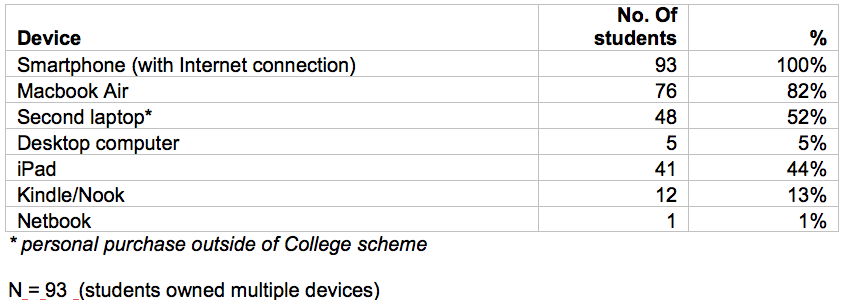


Theme
3AA Mobile learning and social networks
INSTITUTION
Royal College of Surgeons in Ireland - Health Professions Education Centre - Dublin - Ireland

Real-time medical and scientific communication and information is already at our fingertips (1). However, while the potential for computers and information technology to influence fundamental changes to medical education are recognised, these innovations are often initially realised as general consumer products. By their nature, these products quickly appear in teaching settings and it may not be apparent whether the pedagogical imperatives of medical education are served by such developments. As a consequence, understanding of how best to use technological innovations and associated information sources to support heath care providers and patients continues to stimulate considerable debate (2).
Furthermore, access to computers and online information is no longer bound to a desk-based system with a fixed Internet connection, mobile devices with continuous data connections have allowed students to access information while on the move especially in a clinical setting. (3) (4) However, it is important to be cognisant of the fact that the use of Internet based information or any other technology in a teaching context represents a challenge that needs to be tempered with reference to sound pedagogical principles. (5)
A Change to RCSI laptop scheme
At the start of the 2014 academic year, the RCSI laptop scheme was revised to offer clinical medical students two choices, a MacBook Air Laptop or an iPad mini with 3G connection (connection fees fully subsidised RCSI). Whilst the Mac Book Air was a smaller more portable laptop than previously offered to students, it was felt that the iPad could be more amenable for immediate portability and access to information on clinical placements. This ploicy change afforded a research opportunity to explore student experiences of the pedagogical benefits and drawbacks of the aforementioned devices with a view to proposing guidelines and future research-led recommendations for RCSI educators in relation to curricular incorporation of tablet technology. Specifically, the study focussed on positive or negative impact on learning approaches, motivation to learn, engagement, and academic performance.
Approach
We wanted to explore clinical students’ choices and their use of these different devices in the first year of clinical medicine: what they used, how they used it, and why they used it in a particular way. We devised a mixed methods study to investigate this. All students newly entered into the clinical years, who elected to participate in the study (n=93) were issued with an online questionnaire which was based on a review of the literature and our previous experience with students and IT at RCSI. This questionnaire explored personal technology device ownership and use. Subsequently, two different online questionnaires were issued to those students who had opted for either a MacBook Air or an iPad.
We then invited a maximally variant sample (heterogeneity selected on the basis of device and reported use) of these responders to individual semi-structured interviews (n=19) with staff of the Health Professions Education Centre to explore the survey findings in more depth. Interviews were conducted at the time and place of the student’s choosing and continued until saturation of major themes was attained. Field notes and memos were also collected and used to inform the development of major themes.
- Actual patterns of students’ use of various devices and online information are not uniform and are deeply influenced by the presence of patients, which students usually find inhibitory and this is coupled with a sometimes confusing variety of approaches modelled by clinical teaching staff.
- All tools used in the clinical setting signal professional identity and competence, particularly so those associated with the physician personally such as white coats and stethoscopes.
- While these tools have specific functions and may require little explanation to the patient, Internet enabled mobile devices have almost limitless functionality and are directly linked to a multitude of tasks in everyday life.
Diverse use of devices
- Our results portray students as online, mobile and fluently exploiting data and services from a wide variety of sources in both their academic and personal lives.
- While the presence of technology in a medical student’s life may appear to be ubiquitous, our results also highlight differences when technology is used in clinical settings with or without a patient.
- This difference in use is influenced factors such as personal and non-academic experiences rooted personal convictions that using electronic devices with a patient is rude or may be viewed as unprofessional.
- The type of devices that students choose to bring into a clinical setting is diverse and it may not be possible to neatly categoirise a student in technical terms. However, we have found that there are several factors that influence a student’s decision to use a device and in what context.
Use of defvices in a clinical setting
- While students bring a wide variety of devices into the clinical setting, their actual use is linked to personal feelings based on the student’s perceptions of how patients will perceive the use of the device in terms of acceptance and professionalism.
- Guidance to students from teaching staff on the appropriate use of devices is clinical settings can be variable, ranging from total prohibition to direct and open use to support teaching.
- Variability leads to confusion and loss of potential, which could be addressed by institutional guidelines and clear policy.
- Mobile technology is disruptive by its very nature and use in some social settings may be considered inappropriate or have a negative impact.
- The problem arises from the fact that the same device that is such a powerful clinical tool is also connected to social media, email, and other non-medical outlets, posing the potential for inappropriate use in the workplace (6)
RESULTS

We report the major findings starting with quantitative data and then exploring the qualitative data. In addition to the laptop supplied by the medical school, students also possessed an array of personal electronic Internet enabled devices, including a laptop (50.5%) or a tablet computer (44%). 100% of students surveyed have a Smartphone but only 6.5% have a desktop computer. (Table 1). Reported daily used of technology by students for educational purposes was high (94.6%) with the remainder of students (5.4%) using devices on a weekly basis. Daily use of technology for other purposes such as entertainment (83.9%), general web browsing (91.4%) and Communication (93.5%) was also high and reflects an almost constant connection to the Internet and online information services. (Table 2).
While 14.7% of students reported that iPads were useful when patients were present, 64.7% stated that iPads were helpful when patients were not present. Over half (52.9%) of students who opted for an iPad in the College scheme, noted that they never used never used their iPad in a clinical setting where a patient was present.
Data collected during qualitative interviews indicated that students were also using personally owned Internet enabled Smartphones to reference clinical information.
Major themes identified in the qualitative data.
- Connection and devices
- Influence and interaction with patients
- Influence and interaction with staff
Student quotes
Connection and devices
- The laptop made my life… easier. I can take my laptop anywhere with me - - SN_07
- So I'm very dependent on my iPad. It helps me organise pretty much everything.- - SN_03
- I found it really invaluable. I mean… when you’re on rotation, every once in a while you’ll get an hour or two when your team is not really up to anything. And besides, I guess carrying a textbook around with you all the time, there’s really no better way than just having the iPad. - - SN_1
- It’s a horrible thing to be on the wards and not know what’s going on and not know what you’re dealing with. So it’s very comforting to have it, have the phone there and be able to go on straight away and look at things. - - SN_15
- … I just get connected… maybe I get the urge… I'm a connectaholic. SN_17
Influence and interaction with patients
- I don’t feel like it’s appropriate to use it in front of the patient, they might think that I’m just like playing with my iPad instead of doing something so. - - SN_16
- I feel like I might be able to use it maybe a little bit more now that I’m in paediatrics. I’ve been meaning to try it, sort of just like to entertain the kids, get them on your side, that type of thing. Just because kids love tablets. . - - SN_1
- I think it would be strange to type in front of the patient firstly, and I think it interferes with the rapport.
- I find that the second that the phone comes out in the clinical setting, that the patient just sort of…, a barrier goes up. I think they fear that we’re not paying attention to them if the phone is there. So I tend not to take it out, because I just think it kind of creates a barrier between me and the patient, and I don’t like that.- - SN_15
- (the clinical teacher) was busy examining and talking with the patient, so I just went behind the curtain and just Googled it quick.- - SN_17
Interactions with staff
- ... like the doctors will tell you…..It’s unprofessional to use your phone. Older patients especially won’t appreciate it. - - SN_12
- the registrar…..told me...just don’t take out your phones, if you need anything just ask me……that is kind of the rules and stuff. - - SN_14
- I would say it would be more comfortable using it in a GP setting where you have your own desk talking to a patient or like an out-patient clinic probably, more than in the ward . - - SN_09
- ….you know just being on the delivery ward we’re with one patient for quite a long time and … and even if they’re asleep they are saying (staff) use of mobile phones is a big ‘no no’ is actually the wording they use ... you know we have a kind of list of rules and regulations and that’s one of them. - - SN_06
- ..after the procedure was done, the surgeon then used the application and the diagrams of the (iPad) app to explain which muscles exactly he was cutting and which ligaments he was tightening, which approach he took, etcetera. So it was actually very useful. - - SN_10
1. Baumgart DC. Smartphones in clinical practice, medical education, and research. Archives of internal medicine. 2011;171(14):1294-6.
2. Ward J, Gordon J, Field MJ, Lehmann HP. Communication and information technology in medical education. The Lancet. 2001;357(9258):792-6.
3. Ducut E, Fontelo P. Mobile devices in health education: Current use and practice. Journal of computing in Higher Education. 2008;20(2):59-68.
4. Stoddard HA, Piquette CA. A controlled study of improvements in student exam performance with the use of an audience response system during medical school lectures. Academic Medicine.85(10):S37-S40.
5. Fetherston T. Pedagogical challenges for the world wide web. AACE Journal. 2001;9(1):25-32.
6. Gill PS, Kamath A, Gill TS. Distraction: an assessment of smartphone usage in health care work settings. Risk management and healthcare policy. 2012;5:105.
Clarke, E.,Pawlikowska, T., Crehan, M., Burns, J., Bruen C.
Health Professions Education Centre, RCSI.
 Send Email
Send Email